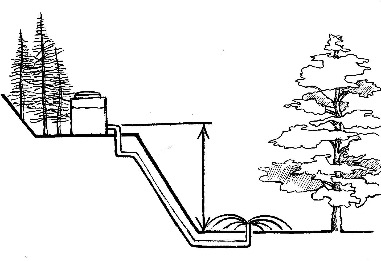

L'irrigation par gravité (irrigation par sillons ou irrigation de surface) est la principale technique d'irrigation utilisée au Tadjikistan pour les cultures annuelles. Afin d'éviter l'érosion, l'irrigation doit se faire par des sillons qui suivent des courbes de niveau légèrement inclinées. L'afflux d'eau doit être lent, afin d'augmenter l'infiltration de l'eau dans le sol et de réduire le risque d'érosion le long du sillon d'irrigation. En outre, des mesures doivent être mises en œuvre pour rendre l'irrigation par gravité plus efficace, par exemple en recouvrant les canaux d'irrigation d'un film plastique pour réduire la perte d'eau par infiltration ou en distribuant l'eau dans les sillons au moyen de tuyaux en plastique pour obtenir une répartition homogène.
Une attention particulière doit être portée pour éviter un arrosage excessif ; l'eau en excès doit être évacuée correctement car elle peut provoquer l'érosion du sol, la formation de rigoles ou attirer les parasites.
Dans un système d'irrigation par gravité, il est essentiel de briser la surface du sol entre les sillons afin de détruire les capillaires et de préserver ainsi l'humidité.
Des techniques d'irrigation plus sophistiquées et plus efficaces, telles que l'irrigation au goutte-à-goutte et par aspersion, ne sont pas économiquement viables dans la plupart des cas pour les cultures irriguées annuelles.
L'eau est une ressource rare au Tadjikistan et la situation s'aggrave avec la croissance démographique et le changement climatique. C'est pourquoi les agriculteurs souhaitent mettre en œuvre des techniques d'irrigation permettant d'économiser l'eau. Le moyen de prédilection est l'amélioration de l'irrigation par gravité, car dans la plupart des cas, il est trop coûteux d'installer des systèmes d'irrigation au goutte-à-goutte ou par aspersion pour les cultures annuelles.
De nombreux agriculteurs irriguent les cultures annuelles par gravité, en laissant l'eau s'écouler vers le bas de la pente, sans savoir qu'une telle procédure provoque l'érosion. Ils devraient être formés à l'irrigation par sillons en suivant les courbes de niveau.